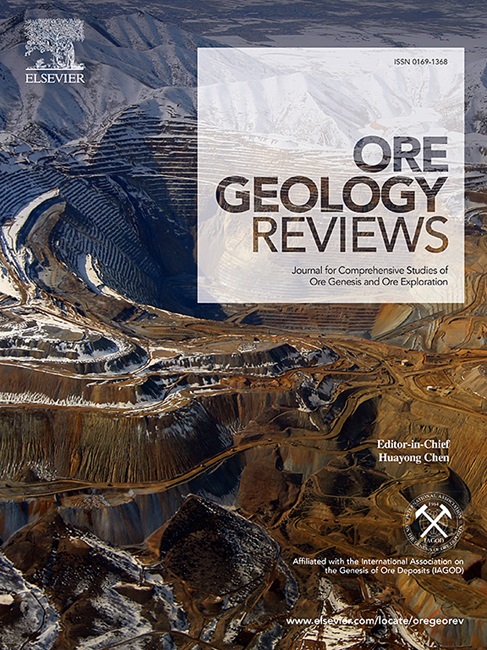Geochemistry of cassiterite and skarn minerals as indicators for formation mechanism and fluid evolution of the newly discovered Jinshui skarn tin deposit in the East Kunlun orogenic belt, NW China
IF 3.2
2区 地球科学
Q1 GEOLOGY
引用次数: 0
Abstract
Discovery of the Jinshui skarn-type tin deposit marked the first instance of a tin deposit to be uncovered in the central segment of the East Kunlun Orogenic Belt (EKOB) in northwestern China. To determine the timing of tin mineralization and elucidate the progression of the ore-forming hydrothermal system, we conducted geochronology of cassiterite and trace element analysis on various minerals hosted in skarn ores. The U–Pb dating results of the cassiterite indicate that tin mineralization took place at 392.9 ± 5.8 Ma, which closely aligns with the syenogranite emplacement at 396.1 ± 2.1 Ma in the Jinshui deposit. This correlation suggests a temporal link between tin mineralization and granitic magmatism. The deposit is characterized by two generations of cassiterite, with trace element analyses consistently showing that the dark cathodoluminescent cores have relatively high W and U concentrations, whereas the bright rims are enriched in Sc, Ti, V, Zr, In, and Hf. Additionally, the Zr/Hf ratios confirm that the syenogranite was the source of the ore-forming fluids. During the prograde skarn stage, the ore-forming fluids maintained an equilibrium closed system. Initially, the ore-forming fluid experienced reducing conditions, characterized by a low water-to-rock (W/R) ratio and a neutral to slightly alkaline pH. This fluid subsequently evolved into an oxidizing fluid with an elevated W/R ratio and an acidic pH. During the retrograde skarn stage, the fluid continued to exhibit high levels of oxygen fugacity. As the mineralization process progressed from the oxide stage to the quartz-cassiterite-sulfide stage, the presence of cassiterite indicates that the ore-forming fluid experienced two increases in oxygen fugacity, and this fluctuation may be attributed to the mixing of external fluids. The post-collisional extensional environment provided the tectonic background for the formation of the Jinshui tin deposit. Magmas derived from mantle sources ascended, and partial melting of the felsic crustal materials led to the formation of the Jinshui syenogranite after differentiation. Skarn-type tin deposits formed at the favorable locations of the contact between the granite body and the Sn-rich Jinshuikou Group.

东昆仑造山带新发现金水矽卡岩锡矿床锡石和矽卡岩矿物地球化学特征及其形成机制和流体演化
金水矽卡岩型锡矿床的发现,标志着中国西北东昆仑造山带中段首次发现锡矿床。为了确定锡矿化时间,阐明成矿热液系统的演化过程,我们对锡石进行了年代学研究,并对矽卡岩矿石中各种矿物进行了微量元素分析。锡石U-Pb定年结果表明,锡成矿发生在392.9 ± 5.8 Ma,与金水矿床的正长花岗岩位位396.1 ± 2.1 Ma高度吻合。这种对比表明锡矿化与花岗质岩浆活动之间存在时间上的联系。该矿床具有两代锡石的特征,微量元素分析一致表明,深色阴极发光岩心具有较高的W和U浓度,而明亮的边缘则富含Sc、Ti、V、Zr、in和Hf。此外,Zr/Hf比值证实了正长花岗岩是成矿流体的来源。在渐进夕卡岩阶段,成矿流体保持平衡封闭体系。最初,成矿流体经历了低水岩比(W/R)和中性至微碱性的还原条件,随后演化为高水岩比(W/R)和酸性ph的氧化流体。在矽卡岩逆行阶段,流体继续表现出高氧逸度。随着成矿过程从氧化阶段向石英-锡石-硫化物阶段推进,锡石的存在表明成矿流体经历了两次氧逸度的增加,这种波动可能与外部流体的混合有关。碰撞后的拉张环境为金水锡矿床的形成提供了构造背景。地幔源岩浆上升,长英质地壳物质部分熔融,分异后形成金水正长花岗岩。矽卡岩型锡矿床形成于花岗岩体与富锡金水口群接触的有利位置。
本文章由计算机程序翻译,如有差异,请以英文原文为准。
求助全文
约1分钟内获得全文
求助全文
来源期刊

Ore Geology Reviews
地学-地质学
CiteScore
6.50
自引率
27.30%
发文量
546
审稿时长
22.9 weeks
期刊介绍:
Ore Geology Reviews aims to familiarize all earth scientists with recent advances in a number of interconnected disciplines related to the study of, and search for, ore deposits. The reviews range from brief to longer contributions, but the journal preferentially publishes manuscripts that fill the niche between the commonly shorter journal articles and the comprehensive book coverages, and thus has a special appeal to many authors and readers.
 求助内容:
求助内容: 应助结果提醒方式:
应助结果提醒方式:


